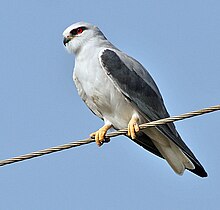Black-winged Kite
| Black-winged Kite | |
|---|---|
 | |
| Conservation status | |
| Scientific classification | |
| Kingdom: | Animalia |
| Phylum: | Chordata |
| Class: | Aves |
| Order: | Accipitriformes |
| Family: | Accipitridae |
| Genus: | Elanus |
| Species: | E. caeruleus |
| Binomial name | |
| Elanus caeruleus Desfontaines, 1789 | |
| Synonyms | |
Elanus melanopterus
| |
The Black-winged Kite (Elanus caeruleus) is a small diurnal bird of prey in the family Accipitridaebest known for its habit of hovering over open grasslands in the manner of the much-smallerkestrels. This Eurasian and African species was sometimes combined with the Australian Black-shouldered Kite (Elanus axillaris) and the White-tailed Kite (Elanus leucurus) of North and South America which together form a superspecies. This kite is distinctive, with long-wings, white, grey and black plumage and owl like forward-facing eyes with red irides. Although mainly seen on the plains, they are sometimes seen on grassy slopes of hills in the higher elevation regions of Asia. They are not migratory, but make short-distance movements in response to weather.
Description
This long-winged raptor is predominantly grey or white with black shoulder patches, wing tips and eye stripe. The long falcon-like wings extend beyond the tail when the bird is perched. In flight, the short and square tail is visible and it is not forked as in the typical kites of the genus Milvus. When perched, often on roadside wires, it often adjusts its wings and jerks its tail up and down as if to balance itself. The sexes are alike in plumage. Their large forward-facing eyes and velvety plumage are characters that are shared with owls and the genus itself has been considered as abasal group within the Accipitridae.
Distribution and habitat
The Black-winged Kite is a species primarily of open land and semi-deserts in sub-Saharan Africaand tropical Asia, but it has a foothold withinEurope in Spain and Portugal. The species range appears to be expanding in southern Europe and possible in West Asia.
Several geographic populations have been named as subspecies and these include the nominate subspecies which occurs in Spain, Africa and Arabia. The subspecies vociferus is found east of this range across South Asia and into Southeast Asia. Along Sumatra, Java, Borneo and the Philippines subspecies hypoleucus(sometimes considered a full species) is found while wahgiensis is restricted to New Guinea. Subspecies sumatranus is not always recognized. The White-tailed Kite and the Black-shouldered Kite were formerly included with this species but have since been treated as separate species.
Although found mainly on the plains they have been seen at higher altitudes in Sikkim (3650m), the Nilgiris (Doddabetta, 2670m) and Nagaland (2020m).
They are said to be winter visitors in some parts of their range such as the Western Ghats.
Behaviour and ecology
The Black-winged Kite breeds at different times of the year across its range. Although nesting has been noted throughout the year in India, they appear not to breed in April and May. Courtship is noisy and involves chases and once the pair is formed they copulate frequently. The nest is a loose platform of twigs in which 3 or 4 eggs are laid. The female spends more effort in the construction of the nest than the male. The eggs are pale creamy with spots of deep red. Both parents incubate but when the chicks hatch, the male spends more time on foraging for food.Females initially feed the young, sometimes hunting close to the nest but will also receive food from the male. After fledging the young birds continue to be dependent for food on the male parent for about 80 days, initially transferring food at perch and later in the air.
The prey include grasshoppers, crickets and other large insects, lizards and rodents. Injured birds, small snakes and frogs have also been recorded.The slow hunting flight is like a harrier, but it will hover like a Kestrel. It has on rare occasions been known to hunt prey in flight. Favourite perches are used for hunting and for feeding but large prey may sometimes be handled on the ground. In southern Africa, they appear to favour roadside verges for foraging and are sometimes killed by collisions with vehicles.
These birds roost communally with groups of 15 to 35 (larger numbers in Europe) converging at a large leafy tree. They are extremely silent and the calls recorded include a high-pitched squeal or a soft whistle. They call a lot mainly during the breeding season.
A species of nematode, Physaloptera acuticauda, has been recorded as a parasite of the species in South Africa.



No comments:
Post a Comment